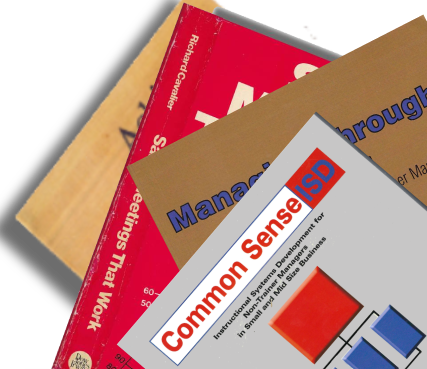
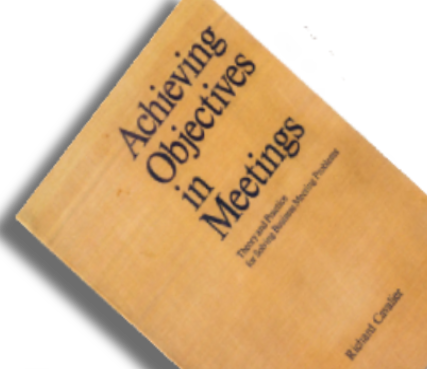
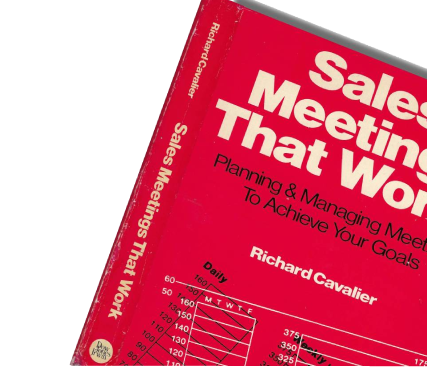
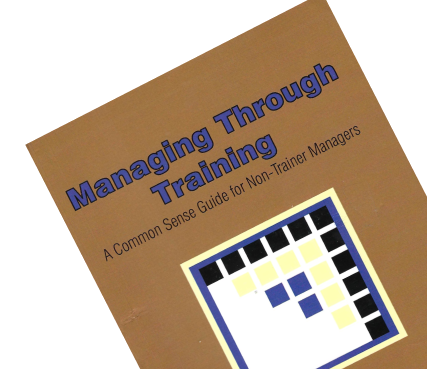
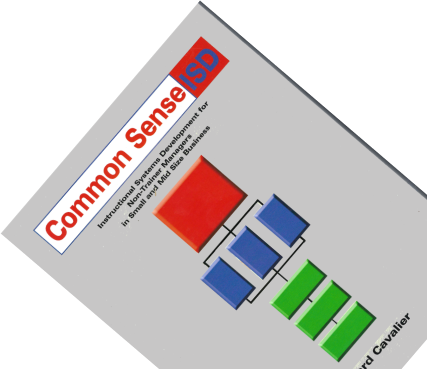
Offering a quartet of old books might seem to have no current value--except that they are a still-usable template and working history of the professional development of the training field since 1960. Except for the American Society for Training & Development (ASTD), which served companies that could afford professional Training Directors, the how-to cabinet was relatively bare. Peter Drucker's first executive how-to book appeared in 1967. This Author's first how-to book and system appeared in 1973. Between, the discursives, user-surveys, and popular opinions had to suffice. Popular and competent are different scales. ASTD's grouping tended to by-pass small businesses in their early years, when know-how is most useful. In recent decades, a commercial industry has subscribed to a "buy something" bias toward business programming. Between, a probably-intended fuzzying of focus occurred. This Author's first book; ("Achieving Objectives in Meetings," 1973) was developed for the basic meeting-manager function, although there proved to be no persons by that title and assignment. Most meetings fulfillment/production in the 1960s was done by stuck-with secretaries of meeting-callers, in their spare time with the help of the company PA: those stuck-with attendees attended the nation's first meeting planner conference; 1971-72 season; called by a United co-originator. Details below. Significantly and curiously, the same lack of basic field how-to for meetings systems and control that greeted "AOM" as the nation's (world's?) first how-to now has a new user: Given the huge advance in general training know-how via the Navy's Instructional Systems Design system (ISD), the training field has an unexpected and needy entry group: the newly-promoted high sales-producer (or any other person with a rare discipline) who became a local-field go-to and how-to source . . . but was suddenly confronted at HQ with dozens or hundreds or thousands of strangers for whose training he/she was suddenly responsible. Even today, because promotions happen constantly. Now what? As a co-founder of the first business-stage consulting service (1960), this Author has one of the meetings field's longest perspectives and resulting additional helps for the stuck-with and other newly-promoted people. Those added helps began a decade after the "AOM" book, with an expanded and enhanced Dow Jones-Irwin update that repeated all of the previously-proved forms plus a PERT Diagram slightly enhanced by user comments. Next, a business-user-friendly true-version of the Navy's ISD original. Some schools teach their own versions, and some private-label versions are sold, once on disc, in simplified format. A broader validation than the military's? Simplification is not compatible with ISD's demand for precise information to support explicit needs, already stated at the start of program design. If you buy and use, be sure an ISD specialist pre-approves it for your needs. Now let's see these orientation comments as expressed in related books: Below: Book rationales; Calendar; White Paper; Credits; Free book-reads. Books: Rationales, in the order published; Business books by Richard Cavalier: "Achieving Objectives in Meetings"; (Corporate Movement; 1973): "AOM" is the nation's (and world's?) first complete system for controlling the development of Agenda and fulfillment (production) duties for large central meetings/training sessions. It included the nation's (worlds?) first complete system and PERT Diagram for controlling the construction of any meeting or training session. Published in 1973 for professional corporate meetings managers/planners--of whom there proved to be none by that title/assignment. The book was well received by, and praised in, related business journals. There were no organizations for a professional meetings management trade--non-existent--prior to 1970s. So an uncoordinated corporate-meetings trade became a profitable purveyor-business industry, as now demonstrated. Unfortunately, "AOM's" publisher went out of business within a few months of publication; so the methodology was fully presented, but the book was no longer available for sales; pre-web. As the sole multi-client, experience-based source, "AOM" established most of the later structure of the meeting field's related programming methodology and much of the terminology for the largely-superficial and profitable meetings industry that developed subsequently. It's significance can be understood in context relating to the circumstances of that time: Business-stage origins are reflected in facts: Until 1960, the meetings field consisted largely of executive retreats, intended primarily as a pressure-relief immediately-following WWII. When the IRS began to ask for business-related purposes for tax deduction, valid reasons were scarce. So, adding national sales force programs became the legitimate response. Executives needed to participate, of course. The nation's (world's?) first consulting service for the business stage was created in 1960 by United Attractions, Inc, Chicago, originally a producer of association banquet shows. Two established clients requested business-stage service from United and accepted suggestions that, in addition to script-edit, the associations use related visuals as learning aids. Until then, visuals in business meetings were considered to be extraneous. Service from existing stage producers was available only in conjunction with a dog-and-pony show. Not association style, even if accepted by many business firms as admired stage shows in freebie magazines. Yet, splashy stage shows generate great magazine covers and stories. As editor and producer for the business-stage, this writer plus Jay Lurye, as production chief at United, were co-creators of United's edit/production biz-stage consulting service. When both clients got compliments, other national associations followed rapidly, as did many corporate members, who had witnessed the change in convention format. An unformed trade was about to be truly professionalized, it seemed. But, in the next year, the industry's second and still largest purveyor-majority association formed, likely by 'borrowing' Lurye's earlier conference attendance list--because no other existed. Lurye was sidelined, but his expertise in physical production was boomed: The newly-formed, purveyor-sponsored association took Lurye's shared production-focus to be essentially the whole of their association's focus. Trade-specific MP associations followed, although trade jargon contributes nothing to the overall information/education format. Ultimately, attention to message was minimized by becoming a voluntary course in most such meeting-planning purveyor syllabi. The morphing was completed by the late 1970s. Editors had the final say about what got published in the pre-web days; so their pro-advertiser bias prevented the printing of contrarian views and university research that challenged ad claims. The meeting planners were wowed by abundant attention and mag compliments on their importance--to the industry? Business interests also ran with the visuals as show-biz, and the industry (distinct from the trade of company users, school researchers, and needed suppliers), morphed its focus from the original emphasis on business needs and purpose (expressed as Agenda) into huge Spectacular! shows, which teach little to anyone. In terms from Dr Malcolm Knowles (an early voice in adult education), "present-moment satisfaction" (indicated by applause) reflects entertainment; whereas he believed present-moment dis-satisfaction is required for motivation to learn and change. This writer had spoken with Dr Knowles (then a Training Director at a major medical association) and borrowed his ideas for message primacy and dis-satisfaction as a learner's motivator. Spectaculars!' are anti-Agenda elements in any program other than entertainment. Fortunately, the COVID-19 shutdown killed huge central meetings and then disproved the 'need' for 'Spectacular!' elements in meetings. Employee communication by phone and email proved that people can understand and work with intelligent information and clear assignments. However, morphing did not occur in a vacuum: The Kodak overhead screen at the 1964 New York World's fair was Spectacular! No one didn't know of it. Then many insecure business meeting-callers demanded "Spectacular!" as the salvation of their meetings. By coincidence, 1964 saw the introduction of McLuhan's mantra, "The medium is the message". The meetings industry had both a profitable sales object and an endorsement. No one mentioned, at that time, that McLuhan had held a contract with a TV manufacturers association before he developed his mantra, which was discredited. Kodak is gone. Between major events, early voices for professionalization of meetings-management/ planning could be heard. In 1970-71 Chicago season, Lurye called the nation's (world's) first conference for meeting planners: World Meetings Planner's Conference. In 1972, as already mentioned, MPI was formed. In 1973, Cavalier published AOM. The meetings trade's two co-originators of the business-stage consulting concept were its first professionalizers and still have the best viewpoints re: original intent and later dilution of educational principles. Lurye's conference participants were self identified, mostly the meeting-callers' secretaries, who were expected to organize the program in their 'spare time,' with the PA's help. Today, it's a full-time job for a staff meeting planner. Why? Corporate Trainers have rules-of-thumb that assign about one week's time for each hour of lectern stage design agendas and stipulate production needs; or about one month's dedicated time for each business day (IRS: Six hours, min). For a full meetings week, that's about thirty week's dedicated time, probably max. How many hours of central meetings does your company schedule? That number of weeks tends to limit your staff meeting planner's needed-time estimate to fulfill production needs. Skilled at both Agenda/purpose-fulfillment and production of needed support elements, Corporate Trainers are better prepared to do all of the work involved in constructing meetings and training sessions than are the special-purpose purchasing agents known as meeting planners, who might belong to any purveyor-dominated meeting planner association. Purveyors' voting domination of 'user-company' associations? Ethical? Ethics was first mentioned in "AOM." Significant, then; not determinative, yet. By using valid books despite age (their advantage is apparent in the long perspective offered), you can prepare yourself both to be better aware of the human and technical aspects of the matter and also to be more-helpful to the Corporate Trainers who work to assist you in creating and delivering an intelligent and effective agenda. There is a more complex alternative to personal opinions, and these books offer tested solutions: "Sales Meetings That Work" (Dow Jones-Irwin; 1983): Because there had been no functional meeting-planner organization(s) in 1973, an expanded, user-friendly expansion of "AOM" was prepared. It addressed stuck-with workers and used all of the fully-proved forms and thought guides of "AOM" and added new controls and forms, as well as a slightly-enhanced PERT Diagram, courtesy of user-comments. "SMTW" recognized both the advances of the trade and the misfiring by the meetings industry as the morphing continued foicus-change from message-primacy to production elements. Still no web existed for balanced information. Again well-reviewed, but seemingly a cause of unhappiness among DJ-I advertisers, whose likely complaints precipitated DJ-I's loss of the unsold balance of copies (my first royalty from MPI's mailing list was nearly $1,000) from the first printing and subsequent cancellation of my publishing Agreement. Curiously, my editor was also released. He created a new publishing company, which DJ-I bought. He was back at DJ-I as an editor but officially not on DJ-I staff-- only a legacy because of a purchased company. Clever? In any case, a moot point because DJ-I no longer publishes books. Although "SMTW" has now been superseded by wider corporate use of Instructional Systems Development (I-S-D) as a proved methodology, is far more accessible than is ISD to newly-promoted but unskilled managers and their staff members, who need basic help but not necessarily with professional-trainer skills. All must prepare meetings and materials for their own departments or branch offices especially if the local secretaries must do some of the work. If you (or company trainer staff) are not already skilled at ISD, this is your route to competent meeting planning . . . until you can find the time and intent to learn to handle ISD with the help of an ISD specialist, if needed. "Common Sense ISD"; (CS-ISD; unwanted by meetings industry; self-published; 2003): In the two decades between the publications of SMTW and CS-ISD, most of American business organizations had become more aware of the value of presenting cogent and comprehensive biz-stage and training sessions. An intrinsic problem was the purveyor tendency to promote spectacular over message. Training associations became more main-stream. Training departments with competent group-communications department heads (not the let's-try-this or that seat-of-pants amateur) became more proficient (although not necessarily more professionally-skilled) at relating programming to facts and participants needed information and skills. Therefore, a more user-friendly approach to the Navy's ISD discipline was needed and provided by this Author: It's "CS-ISD." "Common Sense ISD" ("CS-ISD") is a strict rendering of the US Navy's all-services, award-winner document and system (ISD with PERT Diagram) that controlled the development of the Polaris submarine. It can probably handle your business-meeting needs. The key caveat: ISD guarantees valid, workable programs even the very first time ONLY if its demands for facts and specifics are strictly honored. That's a demanding job for good-enough hedgers! Your key learning task, then, is to work with an ISD specialist on at least your first time around and learn how to interpret each step-by-step demand. Once it's done correctly, ISD's format will keep you on track forever! Where to find a specialist? Possibly in your own corporation's Training Department. Corporate Training Departments are prime employers of military-trained ISD specialists. However, older Trainers who don't know ISD instead suggest the "Let's try this or that" method, which can deliver off-the-mark programs. Some older managers do, in fact, resist ISD because they themselves don't know how to use it. An unskilled Training Director at one of this Author's consulting-client companies had in fact forbid his military-trained specialists to use it. So: If quiet inquiries among your company's Trainers don't identify trained ISD specialists, they're still available. After discharge, most younger specialists will be located in business centers, but the retired could be living anywhere in the country. Suggestion: Place a small ad in a city or regional newspaper asking for help on a one-time project, and you'll probably find a moonlighter who's glad to help. He/she will be in charge of your project, but should work only in your shop, knowingly to instruct while designing. Not possible for a currently employed specialist to be in your shop? Expect to work-out other hours or weekends. It's worth your bending. You'll need facts, paper, and deep-think, not particular surroundings. Once linked, you'll be looking over his/her shoulder all the while, in order to understand how ID determines needed input. So might the secretly-interested non-ISD staff Corporate Trainer(s) want to learn. Learn ISD if you choose, just enough to be confident as a supervisor, with one supervised pass. If not, you have an able assistant, newly identified. There's no need to insult the non-ISD company Trainers--just deliver the perfect departmental program. They'll hear of it and probably ask to learn ISD on the next occasion(s) or in college programs, if they're more than curious. "Managing Through Training" (unwanted prep info; self-published; 2003) Because ISD and even are not do-it-yourself projects for neophytes, was prepared as a half-step into the ISD process. It's ideal for the newly-promoted field wonder who has earned a promotion but does not have the training skills that should go with it. Working-through-others is not the same as selling-to-others--or ministering to them, either. How-to training for the newly-promoted manager or lower-management executive is a needed but vastly unrecognized skill. That's not to say that it wouldn't be useful in other group-com circumstances. In the perspective is focused on the supervised individuals the ones often called dummies because they don't learn complicated ideas or processes from inadequate materials and explanations. MTT should be clear enough so that such mutual-understanding problems don't plague your new position. No, you will not be an expert in ISD from even a close reading. But users will appreciate the reasons that Corporate Trainers or ISD specialists ask for such and much-detailed information: No guesses, please! Purpose: That understanding of ISD's no-guesswork discipline will permit you to deliver valid materials to the people who can help to make your vision a reality--truly useful information and understanding of your own purposes for calling the meeting/ training session. Your own commitment to a structured start is itself a powerful motivator for your new charges. You will never regret the time you invest in learning a people-approach to the people whom you will be supervising . . . through whom you will earn your next promotion! For which you'll be ready! So, are you enough dis-satisfied with your current people-skills to be motivated to learn via and military ISD via ISD? If so, you've found a packet of proved how-tos that will enable you to do a creditable job of creating your first central/group meeting(s) . . . while understanding the reasons for no-guesswork information that assisting ISD specialists will demand while you learn how to make ISD work for you, your program participants, and your company all with you in charge! END Chronology of attempts to professionalize the corporate meetings trade: Meeting Planner: Calendar of Professionalizing Efforts & Defeats: Origins, re-played by Calendar: In 1960, United Attractions, Inc (a Chicago producer of national associations banquet entertainment) created the world's first consulting service for the business stage, as requested by two client national associations. This writer was a co-originator of that business-stage service, editing and visualizing keynote speeches. Visuals were unusual. In 1964, Kodak's overhead screen and film spectacular stampeded insecure meeting-callers toward 'Spectacle!' as their meetings' salvation. McLuhan's now-discredited mantra in the same year aided the stampede. His 'Medium is the Message' issue was created and still survives wrongly targeted! Cavalier's published response: The message is the message. In Chicago's 1970-71 season, Jay Lurye (also a United alumnus) called the world's first meeting for self-identified 'managers' of corporate meetings. Title: World Meeting Planners Conference. Most attendees were self-identified, stuck-with, secretaries of meeting callers, tasked with fulfillment in their 'spare-time.' Corporate trainers can relate dedicated job-time to business-stage time . . . full-time work? Now a full-time staff job? Why? In 1972 (likely using Lurye's list; no other existed), a group of purveyors called the first session of Meeting Planners International (MPI). Purveyors dominated association membership but deferred early votes to user-company members' interests. Ditto in industry-related meeting planner specialty associations. Temporary deference: In the late 1970s, purveyors took voting control of MPI; modified its official name to "Meeting Professionals International" and completed the morphing of focus from message to production. Does a name-change automatically create message-expertise among purveyors? It does dispense with connections to poor early service focuses. Implied message now: "Buy something for better meetings!" Three freebie industry magazines (distinct from the field's professional users and needed suppliers) were/are advertising-dependent and production-oriented. No editor of the freebies has noticed either the contrary university research being published or the inherent conflict in purveyor control of votes. In more than six decades, no purveyor-controlled MP association has ever commissioned an unbiased study of claims vs research. Claims dominate association and publication coverage. Published surveys of user-favored methods determine popularity, not competence. In 1982, Cavalier won the MPI Tony Award for the best (and critical: "fish in a barrel") convention address at their Tenth Annual Convention (despite new name). Pyrrhic Victory: Award won; yet, user-members soon lost voting control to purveyors and sales appeals: Purveyor-voters-majority: conflict of interest? Built-in! Today, with COVID rules relaxed, purveyors are already working to restore business-as-usual. If they succeed, this opportunity to return to message primacy/message-focus can be lost possibly permanently, unless the hidden expense of freebie magazinesí apparent advice is recognized. Read that address at "Reviews & Comments" bar, below. No major jolts since the name changes: Biz-as-usual until COVID. Today, with COVID rules, relax purveyors are already working to restore biz-as-usual if they succeed, this opportunity to return to message-focus can be loss, possible permanently, unless the hidden expense of freebie magazines is recognized. END White Paper: Major cost-savings derived from COVID's remote-work findings. Is there a Training Director who doesn't feel that he/she is over-scheduled and under-funded? Yet, most companies feel that they have committed adequate budget for Meetings & Training. There's the problem! Mismatched objectives and values. Meetings and training are different animals of course, even though many training programs are announced in meetings. However, large centralized meetings that fly people cross-country in order to amortize the cost of huge spaces needed for Spectacular! film presentations are probably wasting more than half of the two-item budget. Spectaculars do get attention, but for themselves, not the meeting-message. For Dr Malcolm Knowles, 'Spectacle!' will qualify as entertainment (present-moment satisfaction), because "present moment dis-satisfaction" is required to promote learning. Good news: Work-at-home because of COVID-19 demonstrated--Surprise!--that employees can understand intelligent communications and specific assignments, with about the same productivity levels. No spectaculars were possible or needed! However, purveyors to large meetings are already making deals--attempting to return to business-as-usual: A mistake for user-companies: If spectaculars are no longer needed, then huge meeting room space is not needed for the equipment that needed to produce the 'default' show: Major cost-savings for user companies. Also, no cross-country or other distant flights are needed to amortize the cost of the show and its huge space and equipment needs: Cost-savings again for dumping huge-space central meetings. These cost-savings are already noted by all user-companies. But are they aware of the opportunities that attend enhanced program planning? Best: Both employee communications and training sessions will benefit from more personalized attention to participants in smaller function groups. These can be held at regional or local facilities, if not at the main office. So, save costs on the unnecessary huge central meetings and make all or most of those savings available to the Training Departments. Trainers are better able than are staff MPs to determine the content and the best surround for their programs . . . and then to oversee the development process. Favorable condition: Competency for related personnel requirements already exists in virtually all companies but is simply un- or under-recognized in the meetings-management context. Awareness matters! The training skill, whether delivered as another chore for the TD (and new hire?), or reporting to the meetings-production group is the answer to the overall skills problem. Given their association's focus on production and purchasing--not meetings content--the staff meeting planner can better be shifted to the Purchasing Department, if cheaper comparisons are considered. Below are dated highlights that support the concepts presented above. Additional (experiential) information and opinion can be obtained on specific inquiry. END